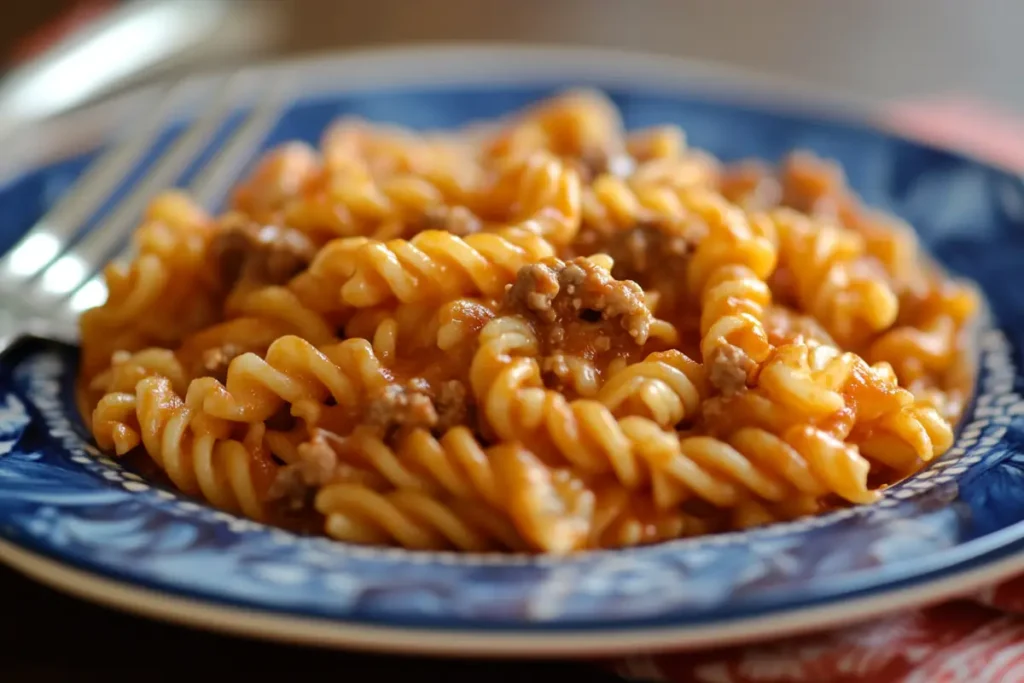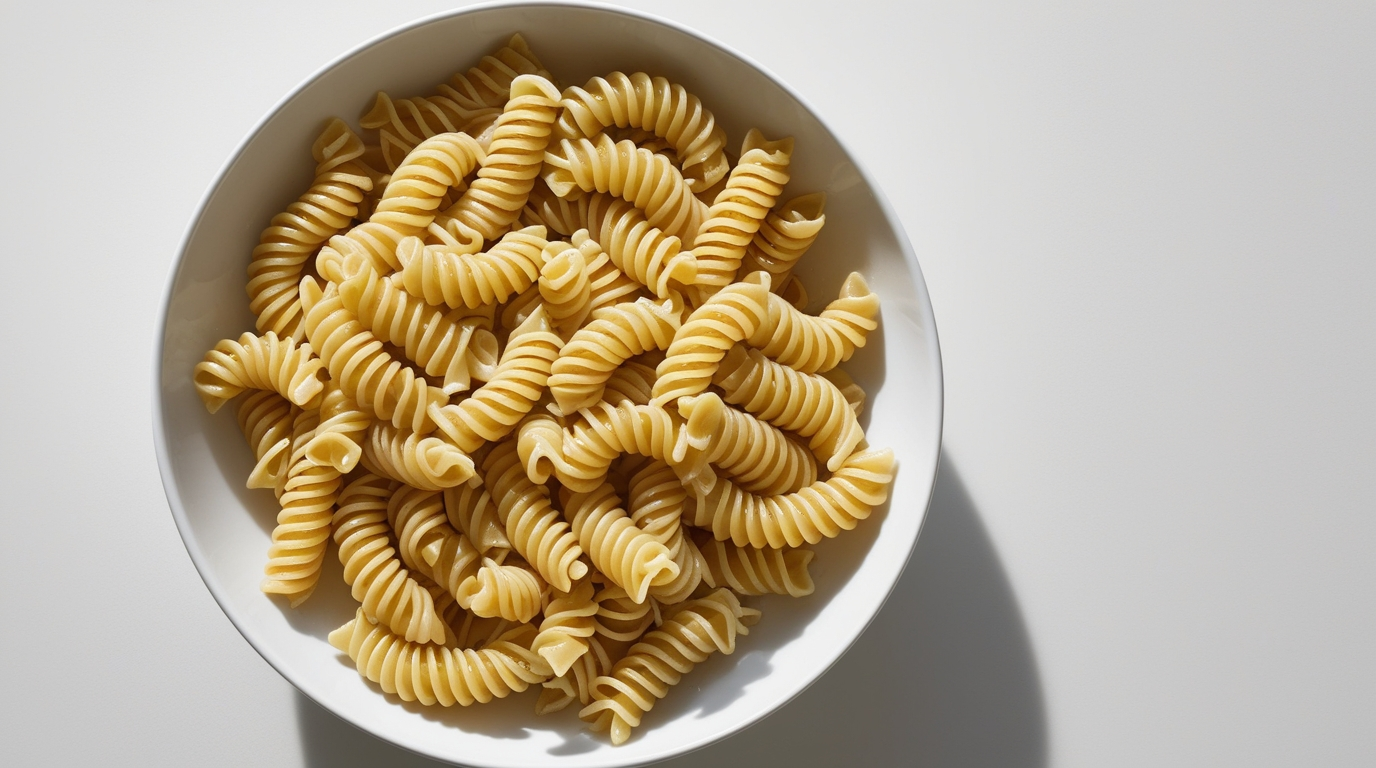Table of Contents
What Exactly Is Fusilli or Rotini Pasta?

Fusilli pasta, also known as rotini in some regions, is a type of pasta characterized by its spiral or corkscrew shape. Its twisted form isn’t just for looks; it helps capture sauces wonderfully. The distinctive ridges and curves make it a great pasta for various recipes. The spirals hold onto sauces both thick and light. In addition, it also gives the pasta a pleasing texture.
The Historical Roots of Fusilli
The exact origins are a bit unclear, but the pasta has strong roots in Italy. It’s believed to have originated in Southern Italy. Its name likely comes from the Italian word “fuso,” meaning “spindle.” This refers to the old way of making the pasta by wrapping dough around a spindle. This method created the characteristic spiral shape. Nowadays, most of it is made by extrusion machines. These machines press the dough through special dies.
Modern Production: How Spiral Pasta is Made Today
Modern production uses machines. These machines are capable of quickly forming the pasta. Initially, durum wheat semolina is mixed with water to make a dough. The dough is then forced through a die with a spiral shape. After that, the pasta is cut and dried. The result is what we see on store shelves. The process is efficient and ensures consistency.
The Distinctive Shape of Fusilli Pasta

The shape is what sets it apart. Its spirals are not just decorative. Its unique shape also plays a vital role in how it cooks. Moreover, it enhances the overall eating experience.
Why the Corkscrew Shape of Fusilli Matters
The spirals make it perfect for holding a variety of sauces. For example, chunky tomato sauces or creamy pesto stick to it very well. Furthermore, the twisting shape also allows for better cooking. It ensures that the pasta cooks evenly. This is because the water is able to reach all sides of the pasta.
Textural Benefits: The Enjoyable Feel of Fusilli
It has a satisfying texture. It’s firm and chewy when cooked right. The spirals create interesting pockets within the dish. In addition, they also add an extra layer to every bite. This interesting mouthfeel is appealing in a variety of dishes. The shape and texture make it a very enjoyable pasta.
Cooking with Fusilli: A Simple Guide
It’s easy to cook and it’s used in many recipes. To cook it, boil it in salted water until it’s al dente. The cooking time usually varies between 8 to 12 minutes.
Basic Steps for Cooking Spiral Pasta
- Bring a pot of water to a boil.
- Add salt.
- Put in the pasta.
- Stir occasionally.
- Cook for 8-12 minutes.
- Drain and rinse with cool water (optional).
Cooking Tips for Perfect Fusilli Every Time
To ensure it is cooked perfectly, be careful not to overcook it. Overcooked pasta can become mushy. Also, be sure to salt the water well. Salted water adds flavor to the pasta. Furthermore, always drain it immediately after cooking. This helps stop the cooking process. Additionally, using a large pot ensures the pasta cooks evenly. Don’t overcrowd the pot with too much pasta.
Popular Fusilli Dishes and Meal Ideas
It is a versatile pasta used in many delicious dishes. It’s often featured in pasta salads, baked casseroles, and pasta with hearty sauces.
Using Fusilli in Refreshing Pasta Salads
It is perfect for cold pasta salads. Its shape holds on to dressing well. Because of this, it’s an excellent choice for salads featuring different ingredients. Mix it with things like olives, tomatoes, cucumbers, and your preferred dressing. Pasta salads are especially popular during the summer. The cold, refreshing flavors combined with pasta are delightful. Moreover, the shape is ideal to grab all the ingredients.
Pairing Fusilli with Various Delicious Sauces
It pairs well with various sauces. Thick, hearty tomato sauces are an ideal pairing. However, lighter sauces such as pesto or alfredo work great too. For a meat-based dish, consider pairing it with a rich bolognese or ragu. The spirals perfectly trap all the goodness. Alternatively, it goes great with cheese-based sauces such as mac and cheese. Because of its structure, it makes a perfect vehicle for flavor.
Delicious Baked Fusilli Casseroles and Recipes
Baked dishes offer a satisfying meal. Combine cooked pasta with sauce, cheese, and other ingredients. Then, bake it until bubbly and golden. A baked casserole with vegetables and different cheeses is a great dinner. The oven baking makes the pasta extra soft. It also melts all the cheese into a delicious dish. Therefore, baked pasta is often a crowd-pleaser. Furthermore, it can be prepared in advance.
Comparing Fusilli to Similar Pasta Types
While it is unique, there are similar types of pasta. These include rotini and spirali. Let’s discuss the differences.
Fusilli vs. Rotini: What Are the Key Differences?
The terms are often used interchangeably. However, there are subtle differences. It typically has a tighter, more distinct spiral. Rotini, on the other hand, may have a looser, more open spiral. However, the differences are not significant. For the most part, these pastas can be used interchangeably in recipes. Therefore, if you can’t find it, rotini is a suitable substitution.
Fusilli vs. Spirali: How Are They Different?
Spirali, like it, also has a spiral shape. The main difference is that spirali’s coils tend to be more uniform and less tightly wound. The texture of spirali may differ slightly as well. Some people find that it is a bit more firm compared to spirali. Generally, they are very similar in terms of cooking and recipe use. You can typically switch them out as needed in your cooking. Because the shapes are very similar, they work in the same types of dishes.
Nutritional Benefits of Fusilli Pasta
It, like most pasta, is primarily made from wheat. So, it’s a good source of carbohydrates. However, the nutritional value can vary depending on whether it’s made with refined or whole wheat flour.
Refined Wheat Fusilli: Nutritional Value and Considerations
Made from refined wheat is mainly carbohydrates. It provides quick energy. However, it is lower in fiber. The refining process removes the outer layers of the grain. This means that it often doesn’t have the added benefits of vitamins or minerals, compared to whole wheat. Because it’s low in fiber, it might not keep you feeling full for a long period of time.
Whole Wheat Fusilli: A More Nutritious Choice
Whole wheat is the better option, when considering nutrients. It retains more fiber, vitamins, and minerals. Fiber aids with digestion and helps you feel full longer. Therefore, opting for whole wheat is a healthier choice. If you are focusing on healthier eating, choose the whole wheat option. In addition, it is a great way to incorporate more fiber into your diet.
Selecting the Best Fusilli for Your Needs
When choosing it, consider your needs. If you prefer white pasta, then select that. However, for those who want a more nutritious option, whole wheat is the best way to go. Also, check the ingredient list. Avoid pastas with too many additives or things you can’t pronounce. Always purchase quality pasta. This simple act helps elevate the quality of your meals. Furthermore, consider the source of the pasta.
Fusilli Around the World: Cultural Adaptations
It isn’t just an Italian staple. This popular pasta has traveled across the world and has been adapted into different variations in different countries.
Regional Fusilli Variations: Local Twists on a Classic
While it is universally recognized, some regions may have their own variations. For example, some areas might prefer a slightly different size or shape of the spiral. Furthermore, local ingredients and flavors may influence how it is incorporated in a dish. Because of its versatility, it adapts well to different local tastes.
Fusilli in Global Cuisines: A Versatile Ingredient
It is incredibly adaptable and can be incorporated into various cuisines. For example, you’ll see it in Mediterranean, American, and Asian-inspired dishes. Its texture and shape are suitable for a wide range of flavor profiles. This is why it is so common in different types of recipes. Therefore, it’s a truly international pasta.
How Different Cultures Utilize Spiral Pasta
Different cultures might use it in unique ways. For example, in some places, you’ll find it in hearty stews, while in others, it might be used in cold salads. Additionally, certain areas pair it with specific spices and herbs. Because of these differences, exploring how different cultures use it is always interesting. Each region adds its special twist.
Serving and Storing Fusilli for Optimal Enjoyment
Proper serving and storage will keep it at its best. Here are some tips to ensure that your cooked pasta is at its peak flavor.
Serving Suggestions for Delicious Fusilli Meals
It is best served immediately after cooking. However, if you need to make it ahead of time, rinse it with cool water. This will help prevent it from sticking together. You can also toss it with a bit of oil. This will also help keep it separate. When serving, be sure to heat your sauce separately. Then, toss it with the pasta. This ensures everything is at its ideal serving temperature.
Proper Storage of Cooked Fusilli
To store cooked pasta, allow it to cool first. Place it in an airtight container. Then, store it in the refrigerator. Cooked pasta can be stored in the fridge for about three to four days. When reheating, add a little water or broth. This helps keep the pasta moist. Reheat it gently on the stove or in the microwave.
Storing Dry Fusilli for Long-Lasting Freshness
Dry pasta should be kept in a cool, dry place. An airtight container is ideal. It will keep out moisture. Dry pasta can stay fresh for several months, if stored correctly. Check the packaging for the expiration date. Always keep it in a place that is free from humidity.
Creative Culinary Uses for Fusilli Pasta
Beyond traditional dishes, there are many creative ways to use it. Here are some out-of-the-box ideas that you can explore.
Adding Fusilli to Hearty Soups and Broths
Adding it to soups and broths adds a bit of substance. Its shape is perfect for capturing the flavors of the broth. A small amount can turn a light broth into a more filling meal. Consider adding it to a vegetable broth or chicken soup. It will add both texture and flavor.
Fusilli and Seafood: A Flavorful Combination
It pairs well with many kinds of seafood. For example, shrimp, scallops, and mussels are excellent choices. Combine cooked pasta with your chosen seafood and a light sauce. Then, sprinkle it with herbs. It holds on to the flavors perfectly. This creates a truly enjoyable meal.
Fusilli in Vegan and Vegetarian Recipes
It is also ideal for vegan dishes. Pair it with various vegetables, plant-based sauces, or plant-based proteins. This ensures that it can be enjoyed by everyone. For example, try it with roasted vegetables and a vegan pesto. There are endless options to choose from.
Why Fusilli is a Great Choice
Pasta stands out for its shape, texture, and flavor. It is enjoyable in many different types of dishes. Its twisted shape is perfect for holding sauce. It offers a unique eating experience. Furthermore, it is easy to cook and is very versatile. It is a great choice for pasta lovers.
The Exceptional Versatility of Fusilli Pasta
Its versatility is a key benefit. Use it in many meals from simple pasta salads to hearty main courses. This means that this pasta is a staple for your pantry. Its shape makes it ideal for catching sauces. Also, the texture is ideal for pairing with many kinds of foods. In addition, it is easy to store, both dried and cooked.
The Delightful Eating Experience: Enjoying Fusilli
The shape and texture contribute to the joy of eating. Each bite offers a pleasant sensation. Moreover, its ability to hold onto sauce ensures a tasty meal. The spiral shape makes each forkful interesting. Therefore, it offers a great experience. Because it holds onto the sauce, it makes for a more flavorful meal.
Making Fusilli a Family Favorite Pasta Choice
It is often a family-friendly option. Because it’s an easy pasta to eat, even for children. Also, it is great for casual weeknight dinners, or more complex meals. This pasta is a great choice for a wide variety of ages. The ease of cooking, and its taste, makes it a winner with many families. Furthermore, it is great for getting even the pickiest eaters to eat.
Conclusion
It is a remarkable pasta. It’s recognized for its spiral shape. It cooks well, and holds sauce beautifully. Additionally, its texture makes it pleasurable to eat. This versatile pasta is used in many great dishes. Whether you’re making a simple meal, or something more elaborate, it is always an excellent choice. Enjoy its unique qualities and the joy it brings to your plate.
Frequently Asked Questions (FAQs):
What type of pasta is fusilli?
Fusilli is a spiral-shaped pasta. It’s known for its twisted form that holds sauces well. It is made from wheat.
Is rotini a fusilli?
The terms are often used interchangeably. Rotini may have a slightly looser spiral. However, they are very similar and can be substituted.
Can rotini be substituted for fusilli?
Yes, rotini can be substituted for it. They are very similar and work well in most of the same recipes.
Is fusilli the same as spirals?
Fusilli is a type of spiral pasta. Therefore, they are similar. However, some spiral pastas can vary in shape and tightness.

